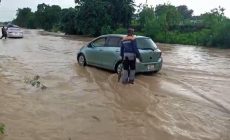GH¢15 million lost to fire disasters in 2013 – NADMO gives statistics
- Posted on
- Comment
 Ghana experienced 478 incidences of fire disasters nationwide in 2013, affecting 11, 766 persons, National Disaster Management Organization (NADMO) said on Thursday.
Ghana experienced 478 incidences of fire disasters nationwide in 2013, affecting 11, 766 persons, National Disaster Management Organization (NADMO) said on Thursday.
The cost of damage of the fires which included some markets in the cities was estimated at over GH¢15 million.
This came to light at the National Platform for Disaster Risk Reduction and Climate Change Risk Management meeting organized by NADMO for stakeholders to take stock of their activities and what they have been doing so far to facilitate disaster management in the country.
According to the report of the National Technical Committee on Fires and Lighting, there were also 15 fatalities during the period and attributed the causes of the fire outbreaks to non-observance of basic fire safety regulations.
The year under review also saw severe flooding/Rainstorms/Windstorms nationwide affecting over 23,000 persons.
Some parts of the Bunkprugu Yunyoo and the East Mamprusi districts in the Northern Region also had their fair share of severe flooding which displaced over 6,000 people in 44 communities.
The year also saw the invasion of caterpillar in the Keta and South Tongu districts of the Volta Region, an assessment exercise was carried out in five communities.
Mr Kofi Portuphy, the National Coordinator of NADMO, said in all the cases his outfit assessed the situations and supported the affected persons and the communities with logistics and strengthened their efforts to mitigate the effect of the disasters.
“NADMO coordinated the response to various disasters across the country with fires, flooding and road accidents as the main incidents. It also responded to various disasters/emergencies including Domestic, Commercial, Industrial and Bushfire nationwide,” he said.
He noted that despite financial constraints the organization had been able to achieve its objectives and successfully implemented most of its programmes.
“It has also provided response to distressed situations and managed other disasters despite its challenges,” he added.
On mitigation, Mr Portuphy said, flood mitigation equipment was used to dredge 14km out of a 28 km Wassaku stream which takes its source from the Volta River and connects to the Songor Lagoon.
“Two dams were also constructed at Bedeku and Fantevikope in Dangme East. This prevented flooding and enabled communities around the stream and its environs have access to potable water and also use it for agricultural purposes.
“They were further used in the expansion and widening of channels and drainage in other flood prone areas such as Weija, LEKMA, among others in the Greater Accra Region and the drainage that join the Kakum River in the Central Region,” he added.
The National Coordinator noted that NADMO had graded and re-shaped the roads, and dredged the drains in the Nkwanta North District in the Volta Region.
He said the Organization worked with the Platforms for Disaster Risk Reduction and Climate Change Adaptation, the Technical Advisory Committees, the Disaster Management Committees and other collaborating agencies in carrying out its functions at all levels.
Mr Portuphy announced that Spaced-based Information for Disaster Management and Emergency Response UN-SPIDER had trained 70 of NADMO staff managing space-based information.
The courses, he said, were organized in collaboration with Bournemouth University Disaster Management Centre, UK, the North Dakota National Guard, U.S.A, Federal Emergency Management Agency (FEMA), Ghana Armed Forces and Staff College (GAFSC), and Earthquake Engineering Research Institute, USA.
He, therefore, pledged their commitment to continue to educate the public on the need to put in measures to prevent disasters instead of allowing them to occur before searching for relief and reconstruction.
-GNA










 (Selorm) |
(Selorm) |  (Nana Kwesi)
(Nana Kwesi)